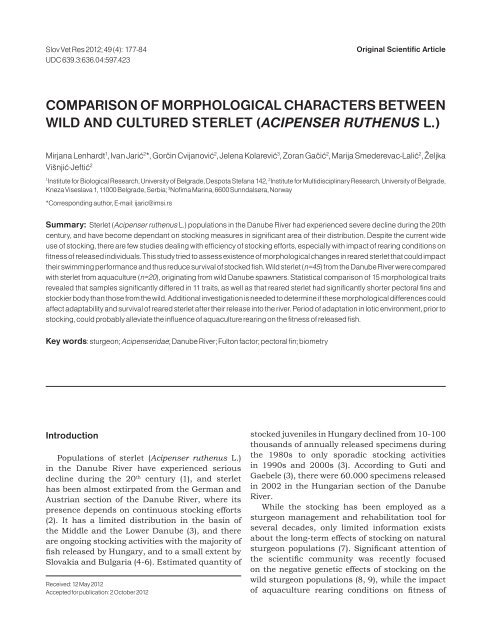SLOVENIAN VETERINARY RESEARCH
SLOVENIAN VETERINARY RESEARCH
SLOVENIAN VETERINARY RESEARCH
You also want an ePaper? Increase the reach of your titles
YUMPU automatically turns print PDFs into web optimized ePapers that Google loves.
Slov Vet Res 2012; 49 (4): 177-84<br />
UDC 639.3:636.04:597.423<br />
Original Scientific Article<br />
Comparison of morphological characters between<br />
wild and cultured sterlet (Acipenser ruthenus L.)<br />
Mirjana Lenhardt 1 , Ivan Jarić 2 *, Gorčin Cvijanović 2 , Jelena Kolarević 3 , Zoran Gačić 2 , Marija Smederevac-Lalić 2 , Željka<br />
Višnjić-Jeftić 2<br />
1<br />
Institute for Biological Research, University of Belgrade, Despota Stefana 142, 2 Institute for Multidisciplinary Research, University of Belgrade,<br />
Kneza Viseslava 1, 11000 Belgrade, Serbia; 3 Nofima Marina, 6600 Sunndalsøra, Norway<br />
*Corresponding author, E-mail: ijaric@imsi.rs<br />
Summary: Sterlet (Acipenser ruthenus L.) populations in the Danube River had experienced severe decline during the 20th<br />
century, and have become dependant on stocking measures in significant area of their distribution. Despite the current wide<br />
use of stocking, there are few studies dealing with efficiency of stocking efforts, especially with impact of rearing conditions on<br />
fitness of released individuals. This study tried to assess existence of morphological changes in reared sterlet that could impact<br />
their swimming performance and thus reduce survival of stocked fish. Wild sterlet (n=45) from the Danube River were compared<br />
with sterlet from aquaculture (n=20), originating from wild Danube spawners. Statistical comparison of 15 morphological traits<br />
revealed that samples significantly differed in 11 traits, as well as that reared sterlet had significantly shorter pectoral fins and<br />
stockier body than those from the wild. Additional investigation is needed to determine if these morphological differences could<br />
affect adaptability and survival of reared sterlet after their release into the river. Period of adaptation in lotic environment, prior to<br />
stocking, could probably alleviate the influence of aquaculture rearing on the fitness of released fish.<br />
Key words: sturgeon; Acipenseridae; Danube River; Fulton factor; pectoral fin; biometry<br />
Introduction<br />
Populations of sterlet (Acipenser ruthenus L.)<br />
in the Danube River have experienced serious<br />
decline during the 20 th century (1), and sterlet<br />
has been almost extirpated from the German and<br />
Austrian section of the Danube River, where its<br />
presence depends on continuous stocking efforts<br />
(2). It has a limited distribution in the basin of<br />
the Middle and the Lower Danube (3), and there<br />
are ongoing stocking activities with the majority of<br />
fish released by Hungary, and to a small extent by<br />
Slovakia and Bulgaria (4-6). Estimated quantity of<br />
Received: 12 May 2012<br />
Accepted for publication: 2 October 2012<br />
stocked juveniles in Hungary declined from 10-100<br />
thousands of annually released specimens during<br />
the 1980s to only sporadic stocking activities<br />
in 1990s and 2000s (3). According to Guti and<br />
Gaebele (3), there were 60.000 specimens released<br />
in 2002 in the Hungarian section of the Danube<br />
River.<br />
While the stocking has been employed as a<br />
sturgeon management and rehabilitation tool for<br />
several decades, only limited information exists<br />
about the long-term effects of stocking on natural<br />
sturgeon populations (7). Significant attention of<br />
the scientific community was recently focused<br />
on the negative genetic effects of stocking on the<br />
wild sturgeon populations (8, 9), while the impact<br />
of aquaculture rearing conditions on fitness of

















